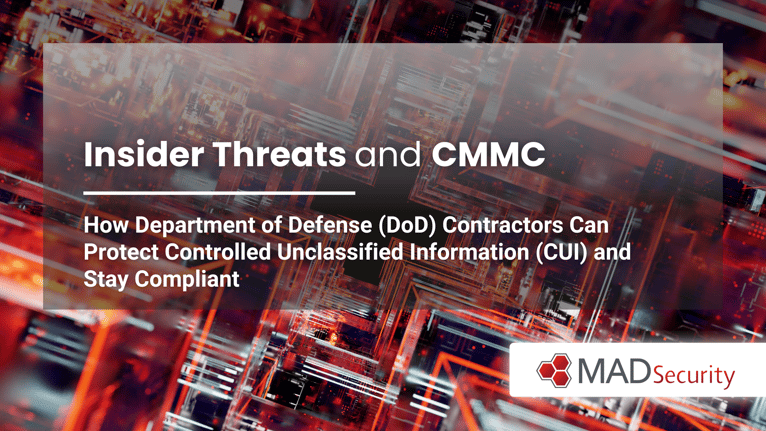
The Growing Risk of Insider Threats in DoD Contracting
.png?width=330&height=186&name=MAD%20SEC%20FT%20IMAGE%20-%20Insider%20Threats%20and%20CMMC%20-%20How%20DoD%20Contractors%20Can%20Protect%20CUI%20and%20Stay%20Compliant%20(1).png) Between 2023 and 2024, there was a 28% increase in insider-driven data exposure, loss, leak, and theft events, making insider threats one of the most pressing cybersecurity risks for DoD contractors. These threats are particularly dangerous because they come from employees, contractors, and third-party vendors who already have access to critical systems and Controlled Unclassified Information (CUI).
Between 2023 and 2024, there was a 28% increase in insider-driven data exposure, loss, leak, and theft events, making insider threats one of the most pressing cybersecurity risks for DoD contractors. These threats are particularly dangerous because they come from employees, contractors, and third-party vendors who already have access to critical systems and Controlled Unclassified Information (CUI).
For DoD contractors, failing to detect, prevent, and respond to insider threats can result in:
| ❌ | CMMC 2.0 compliance failures |
| ❌ | Loss of DoD contracts |
| ❌ | Legal penalties and financial damage |
Under CMMC 2.0 and DFARS 252.204-7012, defense contractors must implement strict insider threat management practices to safeguard sensitive information. Let’s explore how insider threats impact DoD cybersecurity, what real-world cases tell us, and how contractors can stay compliant.
Insider Threat Incidents in DoD Contracting
Real-world cases show that insider threats can come from negligence, espionage, or unauthorized disclosure of classified information.
Data Leaks: The Danger of Poor Cyber Hygiene
- AutoClerk Database Leak
A third-party contractor exposed 179GB of sensitive personal information due to an unsecured cloud server. This breach underscores the importance of supply chain security for contractors handling CUI.
- CMMC 2.0 Compliance Tie-In:
- AC.L2-3.1.1 (Authorized Access Control) – Restrict unauthorized data access
- SC.L2-3.13.11 (CUI Encryption) – Protects the confidentiality of CUI
- CMMC 2.0 Compliance Tie-In:
- Cloud Email Leak (2023)
In February 2023, a misconfigured Microsoft cloud email server exposed thousands of classified military emails, affecting USSOCOM and DoD operations. This incident highlights the risk of cloud misconfigurations in defense cybersecurity.- CMMC 2.0 Compliance Tie-In:
- SC.L2-3.13.8 (Data in Transit) – Protects CUI during transmission
- AU.L2-3.3.1 (Audit Logging & Monitoring) – Enables the detection of unauthorized access attempts
- CMMC 2.0 Compliance Tie-In:
Espionage: Malicious Insiders Stealing Classified Information
- Edward Snowden Case (2013)
NSA contractor Edward Snowden leaked classified intelligence, exposing US surveillance programs. His actions compromised national security and demonstrated the need for stricter access controls.
- CMMC 2.0 Compliance Tie-In:
- AC.L2-3.1.7 (Privileged Functions) – Establishes controls for capturing the execution of privileged functions in audit logs
- AC.L2-3.1.4 (Separation of Duties) – Reduces the risk of malevolent activity without collusion
- CMMC 2.0 Compliance Tie-In:
- Reality Winner Case (2017)
Intelligence specialist Reality Winner leaked a classified report on Russian interference in US elections. She was sentenced to 51 months in prison, reinforcing the legal consequences of insider leaks.
- CMMC 2.0 Compliance Tie-In:
- AT.L2-3.2.3 (Insider Threat Awareness) – Ensures employees understand the risks of insider leaks
- AC.L2-3.1.22 (Control Public Information) – Protects confidential information from exposure
- CMMC 2.0 Compliance Tie-In:
Unauthorized Disclosure: The Risks of Insider Negligence
- Discord Leaks (2023): The Jack Teixeira Case
A Massachusetts Air National Guard member leaked classified intelligence on Discord, exposing US operations in Ukraine. This case revealed a "culture of complacency" and led to disciplinary action against 15 Air Force personnel.- CMMC 2.0 Compliance Tie-In:
- AC.L2-3.1.5 (Least Privilege) – Reduces excessive data access
- AU.L2-3.3.1 (System Auditing) – Enables the detection of unauthorized data transfers
- CMMC 2.0 Compliance Tie-In:
These incidents prove that insider threats are not just theoretical; they are happening now.
Key Indicators of Insider Threats in DoD Organizations
Red Flags to Watch For:
| Unusual access patterns – Employees accessing sensitive files at odd hours | |
| Attempts to disable security controls – Turning off firewalls or security logging | |
| Suspicious USB activity – Plugging in unknown devices | |
| Disgruntled behavior – Employees voicing resentment while handling CUI |
CMMC and Insider Threat Monitoring
| AU.L2-3.3.1 (Audit Logging): Detects abnormal insider behavior |
|
| AC.L2-3.1.5 (Least Privilege): Prevents unauthorized access to CUI |
How to Prevent Insider Threats and Maintain CMMC Compliance
Proven Strategies to Combat Insider Threats
|
|
Implement Least Privilege and Access Controls (CMMC AC.L2-3.1.5) |
| ✅ Restrict access to CUI only to those who need it | |
| ✅ Use Multi-Factor Authentication (MFA) to prevent unauthorized logins | |
| ✅ Monitor privileged user activity |
|
|
Conduct Continuous Monitoring and Log Reviews (CMMC AU.L2-3.3.1) |
| ✅ Deploy SIEM solutions to detect insider threats in real time | |
| ✅ Use Security Operations Centers (SOCaaS) to monitor access patterns | |
| ✅ Conduct regular access audits to remove inactive or unnecessary accounts |
|
|
Train Employees to Recognize and Report Insider Threats (CMMC AT.L2-3.2.3) |
| ✅ Teach staff how to spot phishing attempts | |
| ✅ Enforce mandatory cybersecurity training | |
| ✅ Establish an anonymous insider threat reporting system |
|
|
Secure Endpoints and Networks (CMMC SC.L2-3.13.11) |
| ✅ Implement Endpoint Detection and Response (EDR) solutions | |
| ✅ Block unauthorized USB devices and external drives | |
| ✅ Encrypt CUI data to prevent exfiltration |
|
|
Develop an Insider Threat Response Plan (CMMC IR.L2-3.6.1) |
| ✅ Create a response team to investigate insider incidents | |
| ✅ Revoke access immediately upon termination or resignation | |
| ✅ Forensic analysis to trace data leaks and hold employees accountable |
Implementing these measures will safeguard your contracts and CMMC certification.
How MAD Security’s SOCaaS Protects DoD Contractors from Insider Threats
Why a Managed SOC (Security Operations Center) is Essential
- 24/7 Threat Monitoring: Insider threats often go undetected for months. A managed SOC continuously analyzes user activity, access logs, and network behavior to identify early warning signs.
- Behavioral Analytics: AI-driven behavioral analysis helps identify unusual data access, large file transfers, or privilege escalation attempts before they turn into a full-scale incident.
- Compliance-Ready Reporting: A managed SOC ensures that all security monitoring, incident response, and threat detection activities align with CMMC 2.0 and DFARS compliance requirements.
By leveraging a Managed SOC, DoD contractors gain real-time threat visibility, proactive response capabilities, and continuous compliance monitoring—essential components in mitigating insider threats.
Secure Your CMMC Compliance and Insider Threat Defenses Today
Ignoring insider threats puts your DoD contracts at risk. Are you prepared?
- CMMC 2.0 requires proactive insider threat management. Do you meet compliance standards?
- MAD Security’s expert SOCaaS solutions ensure continuous monitoring, compliance enforcement, and real-time threat detection.
Frequently Asked Questions (FAQS)
What are insider threats, and how do they impact DoD contractors?
Insider threats refer to risks posed by employees, contractors, or third-party vendors who misuse their authorized access to compromise Controlled Unclassified Information (CUI) or classified data. These threats can lead to CMMC 2.0 compliance failures, data breaches, and loss of DoD contracts, making proactive security essential.
How does CMMC 2.0 help DoD contractors mitigate insider threats?
CMMC 2.0 requires DoD contractors to implement strict access controls, audit logging, continuous monitoring, and employee training to prevent insider threats. Key CMMC practices such as AU.2.042 (Audit Logging), AC.2.009 (Least Privilege), and AT.2.056 (Security Awareness Training) help organizations detect, respond to, and mitigate insider risks.
What are the key warning signs of an insider threat in a DoD organization?
Common insider threat indicators include:
- Unusual access patterns (employees accessing sensitive files at odd hours)
- Attempts to disable security controls (turning off logging or firewalls)
- Suspicious USB activity (plugging in unknown devices)
- Disgruntled behavior (employees expressing frustration while handling CUI)
Why should DoD contractors use a Managed SOC for insider threat detection?
A Managed Security Operations Center (SOCaaS) provides 24/7 threat monitoring, behavioral analytics, and compliance-ready reporting to detect insider threats in real-time. By leveraging AI-driven analytics and automated monitoring, a Managed SOC helps DoD contractors proactively identify and respond to insider risks before they lead to security breaches or CMMC violations.
How can DoD contractors ensure compliance with CMMC 2.0 insider threat requirements?
To meet CMMC 2.0 and DFARS 252.204-7012 requirements for insider threat management, DoD contractors should:
- Implement Least Privilege & Access Controls (AC.2.005)
- Monitor and log all activity (AU.2.042)
- Conduct mandatory cybersecurity training (AT.2.056)
- Deploy endpoint security and response solutions (SC.3.192)
- Establish an insider threat response plan (IR.3.098)
Original Published Date: July 22, 2025
By: MAD Security


